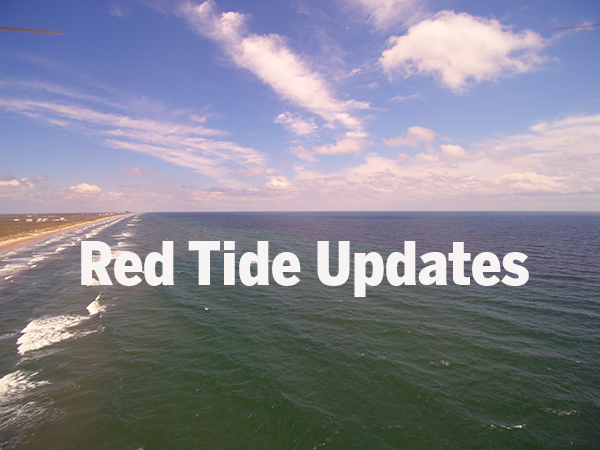Texas Parks and Wildlife Department is working with other agencies to monitor a red tide event along the southern Texas coast. The bloom was first confirmed on Sunday, September 13, by the University of Texas Marine Science Institute who collected samples around the fish pass jetties on Mustang Island due to strong aerosols. Water samples collected and analyzed for Karenia brevis densities are given the following designations:
Background = Less than < 1 cell/ml
Very Low = 1 to 10 cells/ml
Low = 10 to 100 cells/ml
Moderate = 100 to 1,000 cells/ml
High = Greater than 1,000 cells/ml
October 1, 2015 - Red tide levels along the Texas coast currently range from not present to high, depending on location. At the Aransas Pass ship channel at the University Texas Marine Science Institute, currently levels of red tide cells is VERY LOW.
Updated reports from other areas along the Texas coast are found on the Texas Parks and Wildlife hotline (800) 792-1112. Press 4 for ‘fishing’ then 9 for ‘red tide’ then 2 for ‘recent reports’.
The risk of respiratory irritation depends not just on red tide cell numbers but also on water currents, and wind speed and direction. The NOAA Harmful Algal Bloom Respiratory Irritation Forecast for Thursday October 1 through Monday October 5 is:
Region: Forecast Risk of Respiratory Irritation (Duration)
Matagorda Peninsula Region: Low (Th-M)
Bay Region - Matagorda Bay: Moderate (Th-M)
Bay Region – San Antonio Bay to Espiritu Santo Bay: Moderate (Th-M)
Bay region-Aransas Bay to Aransas Pass: High (Th-M)
Bay region-Corpus Christi Bay: High (Th-M)
Aransas Pass to PINS region: High (Th-M)
Bay Region – Upper Laguna Madre: High (Th-M)
Padre Island National Seashore region: High (Th-M)
Mansfield Pass to Beach Access 6 Region: High (Th-M)
Bay region – Lower Laguna Madre to Laguna Vista: High (Th-M)
Beach Access 6 to Rio Grande region: High (Th-M)
All Other Texas Regions: None expected (Th-M)
September 24, 2015 - Regional Updates
Upper Coast (Sabine Lake, Galveston Bay, East Matagorda Bay, Matagorda Bay):
Image Flow Cytobot at Texas A&M Galveston continues identifying Karenia brevis cells at background concentrations near Pelican Island (Galveston).
Mid-Coast Gulf Of Mexico
Over the past 24 hrs., the TAMU Image Flow Cytobot at the UTMSI Pier in Port Aransas has reported K. brevis cell densities maintaining at low concentrations.
San Antonio Bay
No new updates
Aransas Bay
No new updates
 Image near Swanter Park in Corpus Christi on 9/26/2015. Credit: Jace Tunnell.
Image near Swanter Park in Corpus Christi on 9/26/2015. Credit: Jace Tunnell.
Corpus Christi Bay
Streaking continues to be observed along the southern section of Corpus Christi Bay from TAMU-CC to Ropes Park.
Upper Laguna Madre
No
September 24, 2015 - Red tide levels along the Texas coast currently range from not present to high, depending on location. At the Aransas Pass ship channel at the University Texas Marine Science Institute, currently levels of red tide cells are LOW.
Updated reports from other areas along the Texas coast are found on the Texas Parks and Wildlife Department hotline (800) 792-1112. Press 4 for ‘fishing’ then 9 for ‘red tide’ then 2 for ‘recent reports’.
The risk of respiratory irritation depends not just on red tide cell numbers but also on water currents, and wind speed and direction. The NOAA Harmful Algal Bloom Forecast for Wednesday September 23 through Thursday September 24 is:
Region: Forecast (Duration)
Bay region-Aransas Bay to Aransas Pass: High (W-Th)
Bay region-Corpus Christi Bay: High (W-Th)
Aransas Pass to PINS region: High (W-Th)
Padre Island National Seashore region: High (W-Th)
Bay region – Lower Laguna Madre to Laguna Vista: Moderate (W-Th)
Mansfield Pass to Beach Access 6 Region: Moderate (W-Th)
Beach Access 6 to Rio Grande region: High (W-Th)
All Other Texas Regions: None expected (W-Th)
September 23, 2015 - Red tide levels along the Texas coast currently range from not present to high, depending on location. At the Aransas Pass ship channel at the University Texas Marine Science Institute, there continues to be LOW levels of red tide cells.
Updated reports from other areas along the Texas coast are found on the Texas Parks and Wildlife hotline (800) 792-1112. Press 4 for ‘fishing’ then 9 for ‘red tide’ then 2 for ‘recent reports’.
The risk of respiratory irritation depends not just on red tide cell numbers but also on water currents, and wind speed and direction. The NOAA Harmful Algal Bloom Forecast for Monday September 1 through Thursday September 24 is:
Region: Forecast (Duration)
Bay region-Aransas Bay to Aransas Pass: Moderate (M-Th)
Bay region-Corpus Christi Bay: Moderate (M-Th)
Aransas Pass to PINS region: High (M-Th)
Padre Island National Seashore region: Moderate (M-Th)
Beach Access 6 to Rio Grande region: Very Low (M-Th)
All Other Texas Regions: None expected (M-Th)
Cell count numbers are provided daily to UTMSI by Dr. Lisa Campbell with Texas A&M College Station.









